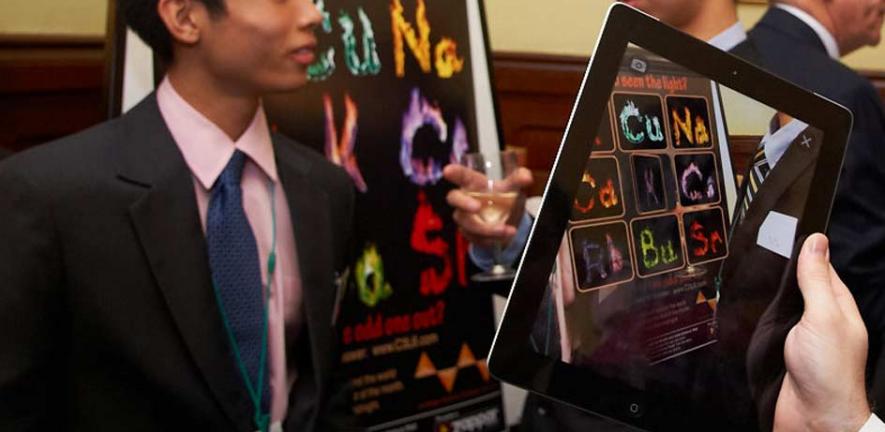
A unique poster that brings flaming elements to life through a smartphone app has been distributed to schools across the UK and further afield as part of the Cambridge Chemistry Challenge, using technology developed in the University’s Department of Engineering.
A unique poster that brings flaming elements to life through a smartphone app has been distributed to schools across the UK and further afield as part of the Cambridge Chemistry Challenge, using technology developed in the University’s Department of Engineering.
In the modern classroom, mobile phones can be the bane of teachers’ lives. An interactive poster produced by Cambridge to promote chemistry in schools is attempting to reverse this, by harnessing smartphone technology developed at the University. The Zappar phone app breathes animated life into chemical symbols featured on the poster, in a bid to encourage more students to investigate the subject.
Distributed in January by the magazine Education in Chemistry, the poster displays a sequence of blazing elements. When the free app Zappar is downloaded and pointed at the poster, the symbols flicker into fiery action. Using the camera feature on the phone, the app creates a ‘mash-up’ of the real and virtual, adding an interactive digital layer to the poster using what’s known as ‘augmented reality’.
Tap a flaming symbol, and the voice of Dr Peter Wothers from the Department of Chemistry gives more information about the element. The poster asks students to identify the odd one out, directing them to the website for the Cambridge Chemistry Challenge, where they are encouraged to take part in a monthly online competition featuring five ‘Google-proof’ chemistry questions. Each question has to be solved to move on to the next, with increasing levels of difficulty, and solving all five merits a place on the Honours Board for that month.
“I put the poster up in the department last Friday morning, and stood by it with my smartphone as students came in for the first lesson of the day. Once the first one had spotted what was going on, I had a steady stream of students downloading the app and using it, sometimes so many that they blocked the corridor!” said Ian Sheldon, Head of Chemistry at Bedford School.
The Cambridge Chemistry Challenge was set up by Dr Wothers to give students and teachers a new and fun way of approaching the subject. Last year, the competition was taken by more than 3,000 students from 250 schools across the country, with the top performing students receiving awards from Cambridge MP and research scientist Dr Julian Huppert, at a ceremony in the Houses of Parliament. It is expected that this year many more students will take part.
“My mission over the past 10 years has been to raise the profile and enjoyment of chemistry amongst students,” says Dr Wothers. “We wanted the Cambridge Chemistry Challenge to get students approaching science problem solving in a way that helps prepare them for undergraduate study. They have to be creative, apply knowledge of other subjects and think in different ways – exactly the kind of skills needed for university.”
“The hope is that initiatives such as this will provide a great opportunity to identify our brilliant scientists of the future.”
The Zappar mobile app, and the augmented reality technology behind it, was developed by former Department of Engineering students Simon Taylor and Connell Gauld during their time at Cambridge, in conjunction with their supervisor Dr Tom Drummond. This is the team’s second collaboration with Dr Wothers, following the chemistry-themed front cover of last year’s Science Festival programme.
"We've applied our technology to a wide range of different things from advertisements to t-shirts, but it's especially rewarding for us to be able to contribute to promoting science education with the Chemistry Challenge," said Simon Taylor, one of Zappar's inventors.
"It is great to be working with Peter and the chemistry department again; Zappar wouldn't be here today if Connell and I hadn't pursued sciences at school and University, and we hope the use of our technology to promote the Chemistry Challenge can play a small role in encouraging more students to continue studying science."
This work is licensed under a Creative Commons Licence. If you use this content on your site please link back to this page.





